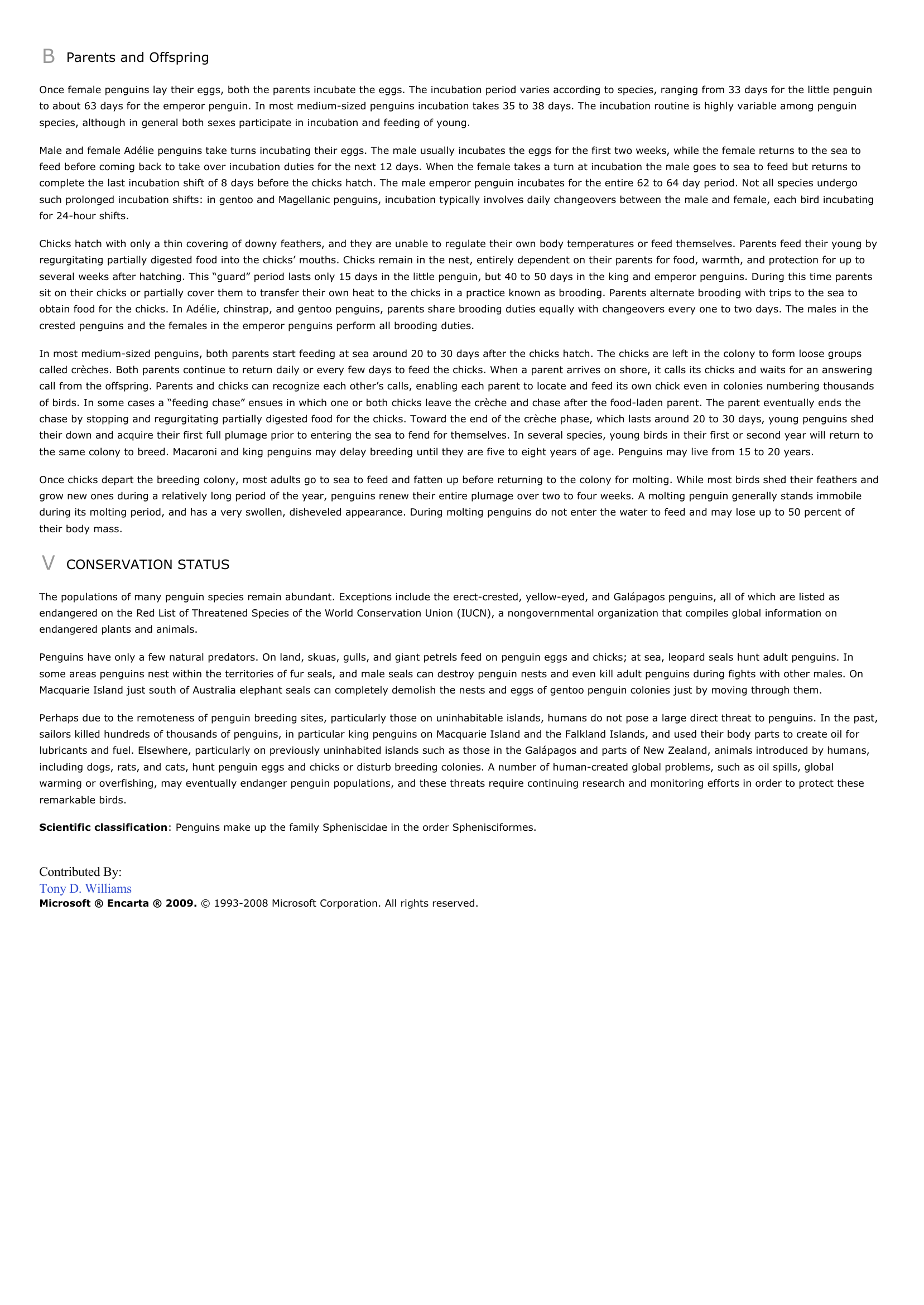Penguin - biology.
Publié le 11/05/2013

Extrait du document
«
B Parents and Offspring
Once female penguins lay their eggs, both the parents incubate the eggs.
The incubation period varies according to species, ranging from 33 days for the little penguinto about 63 days for the emperor penguin.
In most medium-sized penguins incubation takes 35 to 38 days.
The incubation routine is highly variable among penguinspecies, although in general both sexes participate in incubation and feeding of young.
Male and female Adélie penguins take turns incubating their eggs.
The male usually incubates the eggs for the first two weeks, while the female returns to the sea tofeed before coming back to take over incubation duties for the next 12 days.
When the female takes a turn at incubation the male goes to sea to feed but returns tocomplete the last incubation shift of 8 days before the chicks hatch.
The male emperor penguin incubates for the entire 62 to 64 day period.
Not all species undergosuch prolonged incubation shifts: in gentoo and Magellanic penguins, incubation typically involves daily changeovers between the male and female, each bird incubatingfor 24-hour shifts.
Chicks hatch with only a thin covering of downy feathers, and they are unable to regulate their own body temperatures or feed themselves.
Parents feed their young byregurgitating partially digested food into the chicks’ mouths.
Chicks remain in the nest, entirely dependent on their parents for food, warmth, and protection for up toseveral weeks after hatching.
This “guard” period lasts only 15 days in the little penguin, but 40 to 50 days in the king and emperor penguins.
During this time parentssit on their chicks or partially cover them to transfer their own heat to the chicks in a practice known as brooding.
Parents alternate brooding with trips to the sea toobtain food for the chicks.
In Adélie, chinstrap, and gentoo penguins, parents share brooding duties equally with changeovers every one to two days.
The males in thecrested penguins and the females in the emperor penguins perform all brooding duties.
In most medium-sized penguins, both parents start feeding at sea around 20 to 30 days after the chicks hatch.
The chicks are left in the colony to form loose groupscalled crèches.
Both parents continue to return daily or every few days to feed the chicks.
When a parent arrives on shore, it calls its chicks and waits for an answeringcall from the offspring.
Parents and chicks can recognize each other’s calls, enabling each parent to locate and feed its own chick even in colonies numbering thousandsof birds.
In some cases a “feeding chase” ensues in which one or both chicks leave the crèche and chase after the food-laden parent.
The parent eventually ends thechase by stopping and regurgitating partially digested food for the chicks.
Toward the end of the crèche phase, which lasts around 20 to 30 days, young penguins shedtheir down and acquire their first full plumage prior to entering the sea to fend for themselves.
In several species, young birds in their first or second year will return tothe same colony to breed.
Macaroni and king penguins may delay breeding until they are five to eight years of age.
Penguins may live from 15 to 20 years.
Once chicks depart the breeding colony, most adults go to sea to feed and fatten up before returning to the colony for molting.
While most birds shed their feathers andgrow new ones during a relatively long period of the year, penguins renew their entire plumage over two to four weeks.
A molting penguin generally stands immobileduring its molting period, and has a very swollen, disheveled appearance.
During molting penguins do not enter the water to feed and may lose up to 50 percent oftheir body mass.
V CONSERVATION STATUS
The populations of many penguin species remain abundant.
Exceptions include the erect-crested, yellow-eyed, and Galápagos penguins, all of which are listed asendangered on the Red List of Threatened Species of the World Conservation Union (IUCN), a nongovernmental organization that compiles global information onendangered plants and animals.
Penguins have only a few natural predators.
On land, skuas, gulls, and giant petrels feed on penguin eggs and chicks; at sea, leopard seals hunt adult penguins.
Insome areas penguins nest within the territories of fur seals, and male seals can destroy penguin nests and even kill adult penguins during fights with other males.
OnMacquarie Island just south of Australia elephant seals can completely demolish the nests and eggs of gentoo penguin colonies just by moving through them.
Perhaps due to the remoteness of penguin breeding sites, particularly those on uninhabitable islands, humans do not pose a large direct threat to penguins.
In the past,sailors killed hundreds of thousands of penguins, in particular king penguins on Macquarie Island and the Falkland Islands, and used their body parts to create oil forlubricants and fuel.
Elsewhere, particularly on previously uninhabited islands such as those in the Galápagos and parts of New Zealand, animals introduced by humans,including dogs, rats, and cats, hunt penguin eggs and chicks or disturb breeding colonies.
A number of human-created global problems, such as oil spills, globalwarming or overfishing, may eventually endanger penguin populations, and these threats require continuing research and monitoring efforts in order to protect theseremarkable birds.
Scientific classification : Penguins make up the family Spheniscidae in the order Sphenisciformes.
Contributed By:Tony D.
WilliamsMicrosoft ® Encarta ® 2009. © 1993-2008 Microsoft Corporation.
All rights reserved..
»
↓↓↓ APERÇU DU DOCUMENT ↓↓↓
Liens utiles
- Alligator - biology.
- Amphibian (animal) - biology.
- Basilisk - biology.
- Boa - biology.
- Caecilian - biology.













